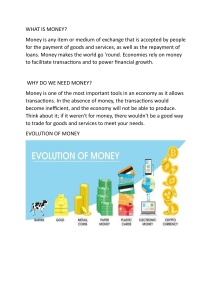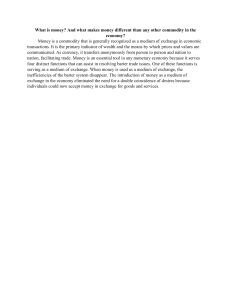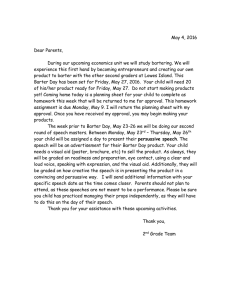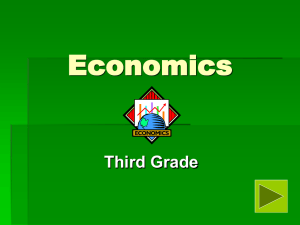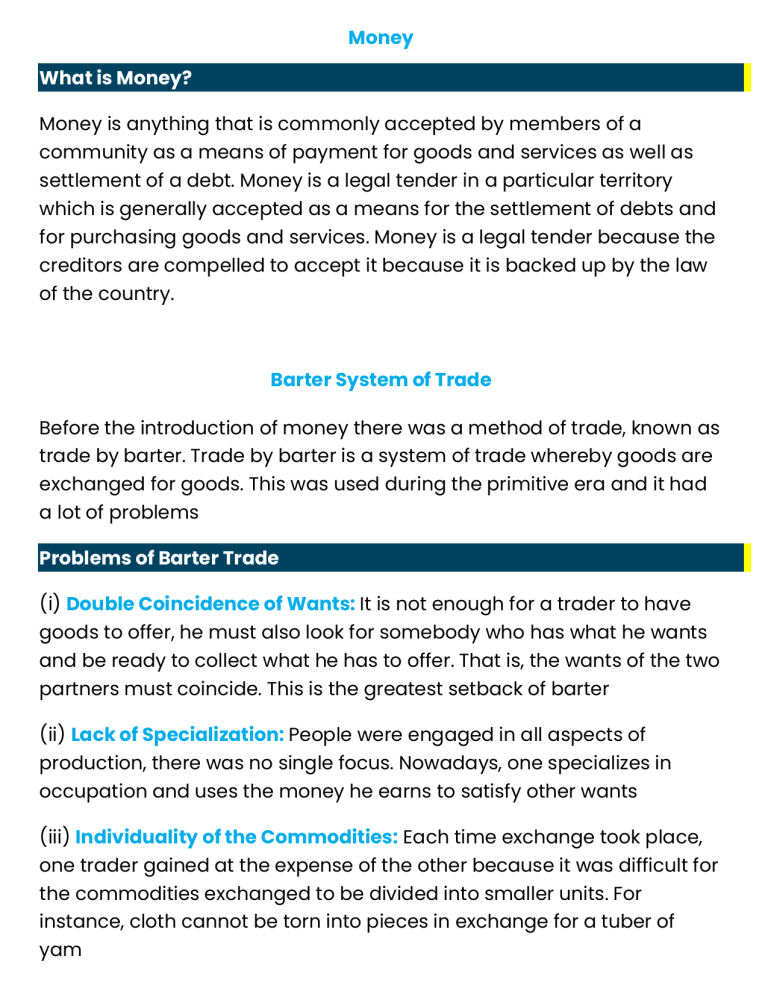
Money What is Money? Money is anything that is commonly accepted by members of a community as a means of payment for goods and services as well as settlement of a debt. Money is a legal tender in a particular territory which is generally accepted as a means for the settlement of debts and for purchasing goods and services. Money is a legal tender because the creditors are compelled to accept it because it is backed up by the law of the country. Barter System of Trade Before the introduction of money there was a method of trade, known as trade by barter. Trade by barter is a system of trade whereby goods are exchanged for goods. This was used during the primitive era and it had a lot of problems Problems of Barter Trade (i) Double Coincidence of Wants: It is not enough for a trader to have goods to offer, he must also look for somebody who has what he wants and be ready to collect what he has to offer. That is, the wants of the two partners must coincide. This is the greatest setback of barter (ii) Lack of Specialization: People were engaged in all aspects of production, there was no single focus. Nowadays, one specializes in occupation and uses the money he earns to satisfy other wants (iii) Individuality of the Commodities: Each time exchange took place, one trader gained at the expense of the other because it was difficult for the commodities exchanged to be divided into smaller units. For instance, cloth cannot be torn into pieces in exchange for a tuber of yam (iv) Lack of Storability: Due to the fact that commodities were used as a medium of exchange, they could not be stored for a long period of time, thus making it impossible to accumulate wealth (v) Lack of Future Trade: There was no chance for credit transaction where one will receive a commodity now and later make his own goods available (vi) Lack of Economic Growth and Development: Barter trade was not only boring but also cumbersome. Long periods of hours used to take place before an exchange was possible Historical Development of Money The problems of barter, especially that of double coincidence of wants led to the introduction of a uniform medium of exchange, known as money. During the early day’s items such as shells, beads, cowries, coppers, silver, and gold, among others were used as forms of money in different parts of the world. These items were not generally accepted because they were bulky and some of them could not be stored for too long. These problems led to the search for easier means of exchange until coins, banknotes, and bank deposits were introduced to replace the other commodities Types of Money (i) Coins: These are metals in form of silver and gold. It has a definite denomination issued and stamped by the central authority responsible for the issuance of money. For instance, the coins in use are kobo which are in different denominations. (ii) Paper Note: It consists of bank notes with definite money value. This is in the form of paper notes originated from the receipts the goldsmiths issued to people. (iii) Bank Deposit: This is demand deposits with the bank. They are withdrawn by means of cheques. It is the money one keeps in one’s bank account for safe-keeping, also called bank deposit, which can be given by bank on the demand of the owner. (iv) Legal Tender: These are all types of money that are generally accepted to be spent and it has legal backing e.g. Cedis and Pesewas are legal tenders only in Ghana. It is backed with the force of law in which makes it generally acceptable (v) Commodity Money: It serves as both commodity and money and has dual values e.g. gold. (vi) Currency: This the type of money being issued in a country e.g. Ghanaian currency is Cedis and Pesewas (vii) Fiduciary Issue: It is in form of note issue which is not backed by gold (viii) Fiat Money: It is the money that is declared by the government order (or fiat), to be legal tender for the settlement of debts but it can’t be converted into anything else Functions/Characteristics of Money Functions of Money 1. Medium of Exchange: This is the primary function of money, a means of payment for goods and services as well as settlement of debt 2. Measurement of Value and Unit of Account: It helps in putting prices or values to goods and services, and also helps in keeping financial records of all business transactions. The real value of money is what it can buy at a particular time. 3. Store of Value: This makes the accumulation of wealth to be possible because money can be kept or saved for future use without any loss of value. In the period of inflation, money becomes a very poor store of value. 4. Standard for Deferred Payment: Money has helped to create credit in business transactions because goods and services can be bought now and payments made in the future. It makes payment to be postponed from the present to a future date. Characteristics of Money 1. Acceptability: It must be generally acceptable to the people of that country, community or a certain territory 2. Divisibility: It must capable of being divided into smaller units e.g. naira and kobo 3. Homogeneity: It must be the same in all aspects 4. Recognisability: The users should be able to recognize or notice it, there should not be confusion in money of the same denomination 5. Portability: Money should be very easy to carry about, it must not be too heavy 6. Storability: It must be capable of being stored for a long time without physical deterioration 7. Relatively Scarce: In order for money not to lose its value, it must be relatively scarce Evaluation Questions 1. Identify the problems of barter system 2. Explain five qualities of good money
